DIY Guide to Building Your Own Modern Windows
Welcome to your go-to guide for DIY window building! Whether you're sprucing up your home with contemporary flair or crafting windows for a brand-new space, this guide will walk you through the essentials. Let's get into the world of modern window construction, where design meets functionality.
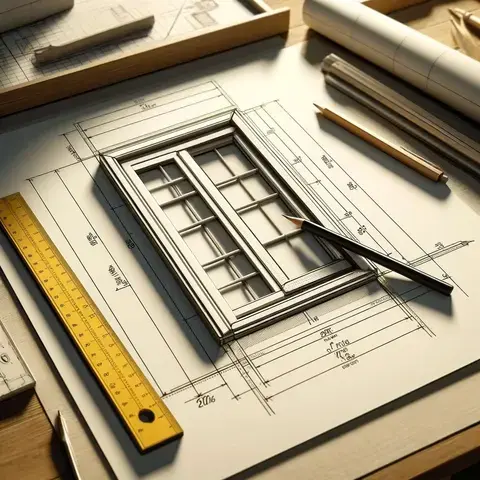
DIY Guide: Crafting Modern Windows for Your Home
This is a free step-by-step guide on building modern windows. Perfect for those who want to add a personal touch to their homes. Let's get into creating windows that are not just functional but also enhance the beauty and efficiency of your space.
The provided detailed guide on building your own window takes you through a coherent, logical progression from planning and designing, to cutting and assembling, installing the glass, applying finishing touches, and finally, weatherproofing and interior finishing. Each step builds on the previous one, ensuring that even beginners can follow along and successfully complete their window project. The guide emphasizes the importance of precise measurements, careful material selection, and meticulous finishing to ensure the window not only looks great but also performs well in terms of energy efficiency and durability.
Understanding Windows: A Brief Overview
The Role of Windows in Modern Homes
Windows are essential for several reasons:
- Light: They fill your home with natural light, making spaces feel larger and more welcoming.
- Efficiency: Well-designed windows improve energy efficiency, keeping your home warm in winter and cool in summer.
- Aesthetics: Windows contribute significantly to the architectural beauty of your home, both inside and out.
What Makes a Great Window?
A great window balances form and function. It should be:
- Durable: Built to withstand the elements and last for years.
- Energy-Efficient: Designed to minimize energy costs.
- Stylish: Enhancing the look of your home.
The Tools and Materials You'll Need
Getting Started
The Essentials: Tools and Materials
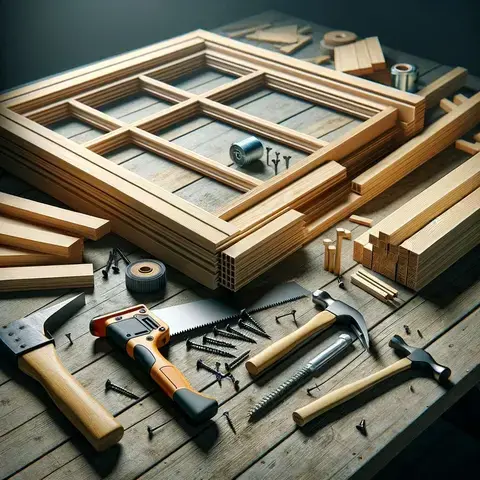
- Measuring Tape: For precise measurements.
- Saw: To cut materials to the right size.
- Drill: For assembling frames.
- Caulking Gun: To seal and weatherproof your window.
Materials
Choosing Your Materials
- Window Glass Types: Double-glazed for better insulation or tempered for safety. Choose from double-glazed for insulation or tempered for safety.
- Frame Materials: Wood offers a classic look, while aluminum provides a modern edge.
- Sealants and Insulation: Essential for keeping out drafts and moisture. Essential for keeping your windows weatherproof.
Step-by-Step Construction Guide
The series of 3D rendered images meticulously illustrates each crucial step in the DIY process of building modern windows, from initial planning and design to the final installation and interior finishing. These visuals serve as a practical guide, offering a vivid portrayal of the transformation from raw materials to a beautifully finished window that enhances the aesthetic and functional aspects of a home's interior. Each image captures the essence of DIY window construction, emphasizing the blend of craftsmanship, design consideration, and the rewarding outcome of creating custom windows that perfectly fit one's personal space and style.
Building Your Window: Step by Step
Creating a window that matches both your practical needs and aesthetic desires requires careful planning, precise execution, and attention to detail. Here's how to tackle each step effectively.
Step 1: Planning and Design
Design Your Window: Sketch out your window design. Consider size, placement, and how it complements your home’s style.
Assessing Your Space
Start by looking at where your window will go. How big is the wall space? Is there anything that could block the window like trees or another building? This will help you decide how big your window should be.
Light and Direction
Consider how the sun moves across your property. North-facing windows might not get direct sunlight, which is cooler. South-facing ones can bring warmth but might need shading. The direction affects both the light and the thermal efficiency of your window.
Design Integration
Think about your home's style. A modern home might suit large, minimalistic windows, while a cottage might benefit from smaller, paneled windows. Your window should complement your home's design, not clash with it.
Step 2: Cutting and Assembling the Frame
Measure Twice, Cut Once: Measure your window opening carefully. Accuracy here is key to a snug fit.
Measuring and Cutting
With your design set, measure your space again. Double-check your numbers before you cut. Use a reliable saw for clean, straight cuts on your frame materials. Whether you're using wood, vinyl, or aluminum, precision is key.
Step 3: Build the Frame
Assemble your window frame according to your design. Ensure it's square and fits the opening perfectly.
Assembling the Frame
Lay out your cut pieces on a flat surface to form the window frame. Use corner clamps to hold the frame in place and ensure it's perfectly square. For wooden frames, screws or nails might be used for assembly, while metal frames might require welding or specialized connectors. Ensure it fits snugly in your designated space without forcing it.
Step 4: Installing the Glass
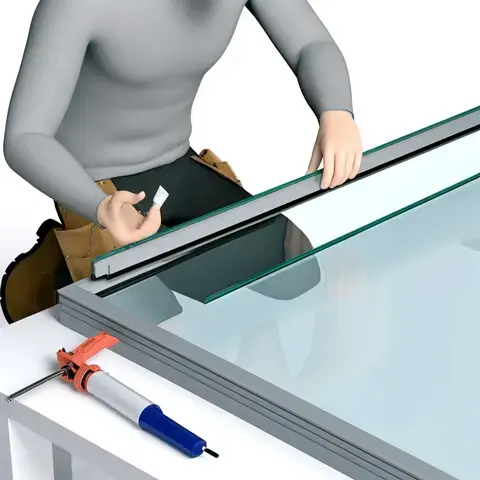
Carefully place the glass into the frame. Use sealant to secure it and wipe away any excess.
Handling Glass
Be cautious with the glass pane. Wear gloves and safety goggles to avoid injuries. If you're using double-glazed units, remember they're heavier and might need an extra set of hands.
Step 5: Seal and Insulate
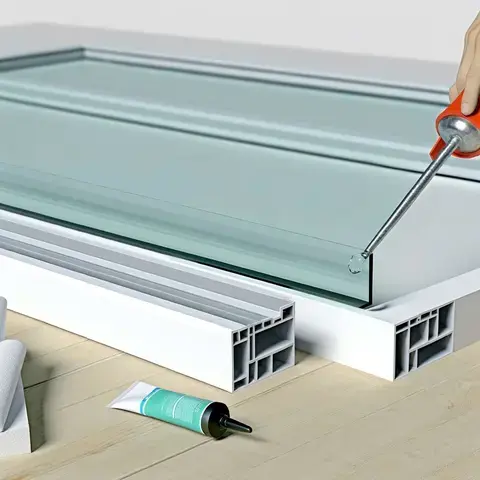
Apply insulation around the window frame to prevent drafts. Finish with a bead of caulk for a clean, weatherproof seal.
Placement and Sealing
Gently place the glass into the frame. It should fit snugly without too much force. Use glazier's points or clips to secure the glass in place if necessary. Then, run a bead of silicone sealant around the edge where the glass meets the frame, both inside and out. Smooth it out with a caulking tool to ensure a watertight seal. Pay extra attention to the corners and any joints.
Installing the Window
Carefully lift the completed window into the opening. Use shims to adjust for a perfect fit, ensuring that the window is level and plumb. Once positioned correctly, secure the window in place using screws or nails, depending on the frame material and the structure of your home. Be mindful not to overtighten, as this can warp the frame and affect the operation of the window.
Remember, the quality of your work here affects not just the look of your window but its performance in terms of insulation and weatherproofing. Taking your time to measure accurately, cut precisely, and seal thoroughly will ensure your window stands the test of time and functions as beautifully as it looks.
Step 5: Finishing Touches and Weatherproofing
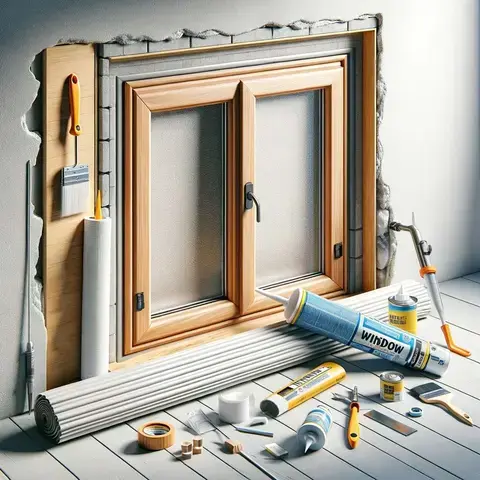
Applying the Finish
Once the glass is securely in place and the sealant has dried, it's time to focus on the finishing touches. If you're working with a wooden frame, you might want to paint or stain it to match your home's exterior. For metal frames, consider applying a protective coat to prevent rusting or corrosion. Ensure any finish you apply is even and covers all exposed surfaces to protect against the elements and maintain the window's appearance over time.
Weatherproofing
Adding weather stripping around the window frame is crucial for creating an energy-efficient window that blocks drafts and moisture. Measure the perimeter of the window to determine the length of weather stripping needed. Choose a durable material suitable for your climate. Install the weather stripping according to the manufacturer's instructions, making sure it compresses slightly when the window is closed to form a tight seal.
Exterior Caulking
To fully weatherproof your window, apply a bead of exterior-grade caulking around the outside of the frame where it meets the house. This adds an additional layer of protection against water infiltration and helps to insulate your home. Smooth the caulking with a wet finger or tool for a clean finish.
Step 6: Interior Finishing
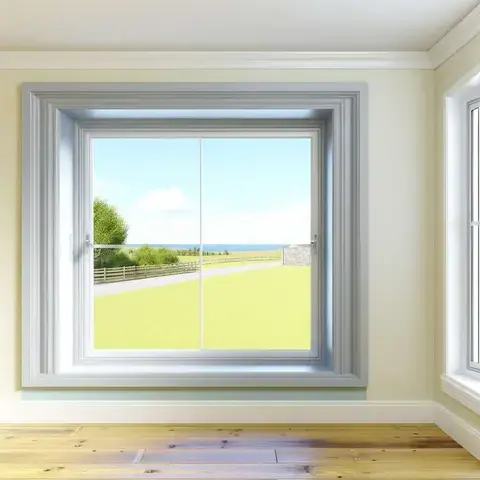
Modren Interior Trim
Adding trim around the inside of the window not only covers any gaps but also gives your window a polished look. Measure and cut your trim pieces to fit, then nail or glue them in place. Fill any nail holes with wood filler, sand smooth, and apply paint or stain to match your interior décor.
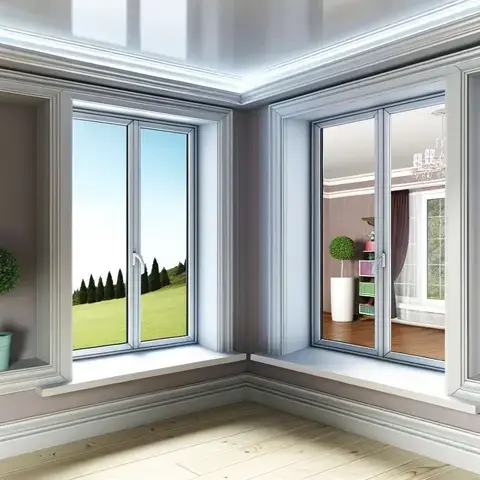
Cleaning and Maintenance
Give your new window a good clean to remove any fingerprints, dust, or excess caulk. Use a soft cloth and a window cleaning solution to polish the glass for a sparkling finish. Moving forward, regular cleaning and periodic checks for any cracks in the sealant or signs of wear will help keep your window looking great and functioning well.
Building your own window can be a rewarding DIY project that not only enhances the aesthetic appeal of your home but also improves its energy efficiency. By following these detailed steps and taking your time to ensure quality workmanship, you can create a window that you'll be proud of for years to come. Whether you're aiming for a modern, expansive window to brighten your living space or a traditional design that fits the character of your home, the skills you've developed through this process will serve you well in all your future home improvement projects.
Customizing Your Windows
Adding a Personal Touch
Colored Frames
Example 1: Imagine a sleek, modern home where the windows feature bold, black frames. These aren't just any windows; they are statement pieces against the home's white exterior walls, turning what could be ordinary into something extraordinary.
Visual Concept: A rendering of a minimalist house at dusk, where the contrast between the black window frames and the stark white walls is highlighted by the warm glow of interior lights.
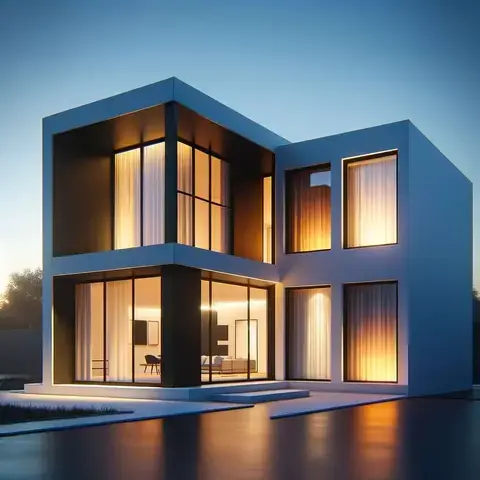
Frosted Glass for Privacy
Example 2: Consider a bathroom with frosted glass windows. These windows ensure privacy while still allowing natural light to flood the space, making the bathroom feel both secure and airy.
Visual Concept: A bright, sunlit bathroom showing frosted glass windows. The light diffuses through the frosted glass, casting a soft glow across a clawfoot tub and marble counters.
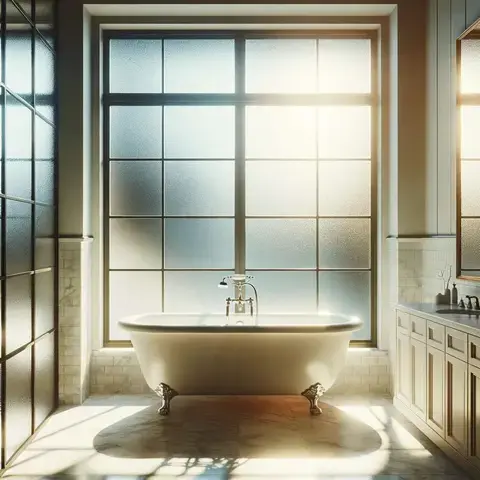
Built-in Blinds
Example 3: A child's bedroom with windows that have built-in blinds between the glass panes. These blinds can be easily adjusted to darken the room for naptime or let in light for playtime, all without any cords posing a risk to safety.
Visual Concept: A colorful child's bedroom in the morning, sunlight filtering in through windows with partially raised built-in blinds, showcasing the ease of controlling light and privacy.

Energy Efficiency Upgrades
Double-Glazed Windows
Example 1: A cozy living room in winter, where the family gathers without feeling the chill, thanks to the double-glazed windows that keep the warmth inside. The windows also prevent condensation, keeping views clear even in cold weather.
Visual Concept: A family room with a snowy landscape visible through the window. Inside, the room is warm and inviting, demonstrating the thermal insulation provided by double-glazed windows.
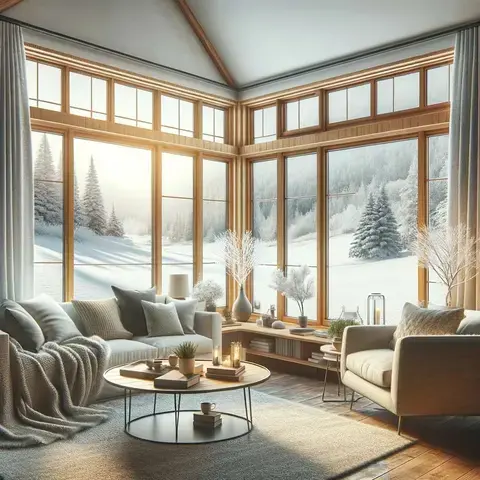
Low-Emissivity (Low-E) Glass
Example 2: A sunroom that remains comfortable all year round, thanks to windows fitted with low-E glass. In summer, the glass reflects heat away, keeping the room cool. In winter, it reflects heat back inside, warming the space.
Visual Concept: A sunroom showing the transition from summer to winter. One half is cool and shaded, with vibrant green plants; the other is warm and sunny, with a snowy scene outside, highlighting the seasonal adaptability of low-E glass.

Each of these examples and visual concepts highlights the potential for customizing windows not just for aesthetics but for practicality, improving the living experience through thoughtful design and technology.
Maintenance and Upkeep
Regular Cleaning
Keep your windows looking great with regular cleaning. A simple solution of vinegar and water works wonders.
Seasonal Checks
Inspect your windows seasonally for any cracks in the sealant or signs of wear and tear.
Conclusion: The Satisfaction of DIY Windows
Building your own windows is not just about saving money; it’s about creating something that perfectly fits your home and your style. With the right tools, materials, and a bit of elbow grease, you can transform your living space with natural light and a fresh, modern look.
Remember, the key to successful DIY projects is patience and preparation. Take your time, measure carefully, and don't be afraid to ask for help when you need it. Happy building!
Explore Further
Learn more about enhancing your living spaces and improving home efficiency through the strategic use of windows. Below is a curated list of topics that delve deeper into areas related to window design, construction, and the broader context of architectural innovation. These subjects will help you gain a more comprehensive understanding of how windows can transform both the aesthetic and functional aspects of your home.
Energy Efficiency and Sustainability
The Science of Window Insulation
Explore the principles behind window insulation and how different types of glass and framing materials contribute to energy conservation within a building.
Sustainable Home Design
Learn about the role of windows in creating eco-friendly homes that not only reduce energy consumption but also minimize their environmental impact.
Architectural Design and Aesthetics
Architectural Styles and Window Design
Discover how windows contribute to various architectural styles, from classic to contemporary, and how they can be used to complement or contrast with a building's overall design.
The Art of Natural Lighting
Understand the importance of natural lighting in architectural design, including how to strategically place windows to maximize light while maintaining energy efficiency.
DIY and Home Improvement
DIY Window Installation and Maintenance
Get hands-on with detailed guides and tips for installing, sealing, and maintaining windows to ensure they remain functional and attractive over time.
Smart Windows and Home Automation
Dive into the future of window technology, exploring how smart windows and automated shading systems can enhance comfort, privacy, and energy efficiency.
Historical Perspectives
Evolution of Windows in Architecture
Trace the history of windows from their earliest forms to the present day, highlighting key innovations and the changing role of windows in architectural design.
Iconic Buildings and Their Windows
Study famous buildings around the world known for their unique window designs, and learn how these windows contribute to both the aesthetic and functional aspects of the structures.
Health and Well-being
Windows, Well-being, and Mental Health
Explore research and insights into how access to natural light and views of the outdoors through windows can improve mood, productivity, and overall mental health.
Environmental Impact
Windows and the Urban Heat Island Effect
Learn about the urban heat island effect and how the design and placement of windows in buildings can mitigate or exacerbate this phenomenon, affecting both indoor and outdoor environments.
By exploring these related topics, you'll gain a richer understanding of the multifaceted role windows play in architecture, design, and daily life. Whether you're a DIY enthusiast, an aspiring architect, or simply someone looking to make your home more comfortable and efficient, there's always more to learn about the world of windows.
